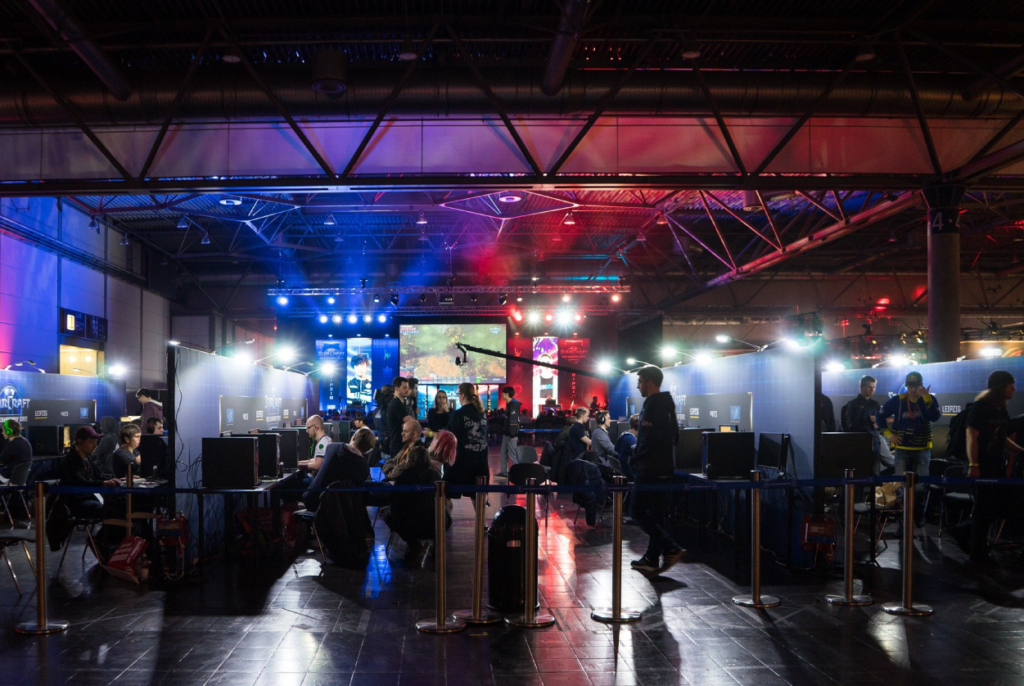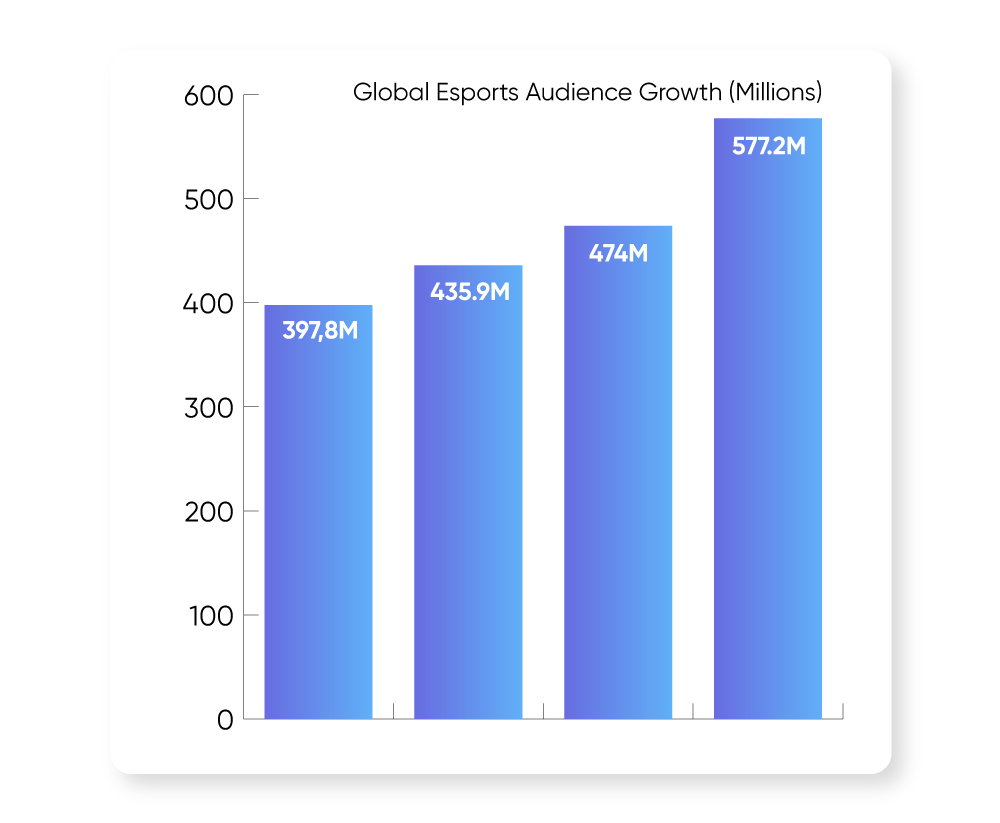
The word “esports” stems from electronic sports and is the competitive leg of video games. The most skilled players of each game face off in tournaments and matches all over the world. The biggest esports games include League of Legends, CS:GO and Dota 2.
Esports has grown fast in recent years, much thanks to the ease of viewership and adoption, as well as the big player bases of many games. League of Legends alone has around 114 million players all over the world, which is roughly the amount of players for cricket and golf combined.
The Most Popular Esports Games
Several games have reached mainstream popularity both in regular play and in the competitive scene. According to Newzoo’s viewership statistics from Twitch for Q1 2021, the most popular games proved to be League of Legends, Counter Strike: Global Offensive, Dota 2, Rocket League and Valorant. The ones which have climbed to the top of the ladder have often held that position for years, largely due to their dedicated player bases, high skill cap and proper funding. Nevertheless, there are also some newcomers, such as Valorant.
- League of Legends (LoL) is a MOBA developed by Riot Games. It has several game-modes and maps, of which “Summoner’s Rift” is the most popular. 5v5 players compete on a map to destroy the other teams’ Nexus. LoL is free to play, but allows for in-game purchases of skins, cosmetics and more.
- Counter Strike: Global Offensive (CS:GO) is a tactical shooter developed by Valve Corporation. The 5v5 shooter is one of the most popular esports titles due to its fast pace and dynamic gameplay. The game is free-to-play, but weapon skins can be bought in game.
- Dota 2 is a MOBA developed by Valve Corporation. It is widely recognised as the game that popularised the genre and has a steady player base, even if it has a steeper learning curve than LoL or CS:GO. It is free-to-play but offers in-game purchases of skins.
- Rocket League is a sports game developed by Psyonix. The 3v3 soccer-game is played with cars on maps similar to soccer-fields. The game is free-to-play and can attribute its popularity to its fast and exciting gameplay.
- Valorant is a Tactical Shooter developed by Riot Games. The game is a newcomer to the esports scene and was released in May 2020. It has reached a steady player base and has quickly become a force to be reckoned with The gameplay is strikingly similar to CS:GO and has influences of Overwatch as well with its hero based character selection.
Read more about the most popular games for 2021 here
The Different Parts of the Esports Ecosystem
Game Publishers
The esports games are the game publishers’ IPs. This essentially means that the publishers have the right to decide who’s able to create a tournament, stream gameplay or play a game. This affects the esports of the games substantially. The tournament structure, esports strategy and international coverage often depends on the stance of the publisher. For example, Riot Games has preferred to keep their professional esports efforts for Lol in-house, holding exclusive rights to the tournaments in the game. This has led to a top-down tournament structure, which has worked well for the game. The Worlds Championships in LoL reach new record-viewerships almost every year.
Riot Games has a very different stance on Valorant. Everyone can create a tournament as long as they follow the game publishers rules and guidelines. The reason for Valorant being more open, is because the Riot Games wants it to grow organically. Time will tell if the game will be taken in-house in the future, or if Riot Games will continue keeping it open for all tournament organisers.
Tournaments

Large competitive games such as LoL and CS:GO are played in both international and regional tournaments all across the globe. While game publishers organise some tournaments directly, tournament organisers such as ESL, BLAST and Dreamhack organises several tournaments and LAN-events as well.
The largest tournaments have been hosted in various capitals of the world, with live viewerships of the tens of thousands of people. The tournaments are also broadcasted for free on platforms such as Twitch and Youtube. This has made them widely accessible for anyone wanting to watch. The ease of viewership and lack of country-based teams has made the esports audience inherently international, as anyone can be a fan of any and all esports teams. It has also been reflected in the viewership numbers. League of Legends Worlds had 3.8 million concurrent viewers in 2020 alone.
Teams

Image Credits: Ron Lach from Pexels
Due to esports being digitally native, the competitive teams in the space differ quite a lot to their counterparts in traditional sports. Players could essentially be in the same team, but play from different parts of the world. However, due to server response times, it mostly makes sense to keep the players in the same place. Therefore, teams usually have “houses” setup where players live and practice together.
Team Franchises
The teams and organisations in esports tend to be more diverse than in regular sports. Regular sports teams are often centered around specific sports, while most esports teams have franchises in different games. For example, NAVI has multiple rosters in CS:GO, Dota 2 and PUBG. Consequently, the team can get visibility and publicity in several spaces in the esports industry.
Diversifying Business Models
Esports teams also diversify their business models. Sports teams get most of their revenue from activities related to matches, sponsorships and prize money. Esports teams get their revenue from sponsorships and prize pools as well, but are severely lacking in match-related revenue since there aren’t any home- stadiums or cities in the same sense. This has led many of them to diversification into different fields, such as content creation and marketing. A lot of teams work in different spaces and are part of bigger organisations. For example, Luminosity Gaming and Vancouver Titans are both owned by esports giant Enthusiast Gaming, who also has publications such as Dotesports and Upcomer under its umbrella.
Players

The great thing about esports is that there is a low barrier to entry. For sports, many personal attributes matter – physical build, location and financial situation. In esports, anyone with a computer and internet connection can participate. For mobile esports, the barrier is even lower. A player only needs a smartphone to be able to play. This opens up for players from all around the world, which has also been evident in mobile esports. The industry is mostly fuelled by players and viewers from emerging economies such as India, Thailand and Brazil.
The competitive players in esports are less limited in career choices than sports athletes. In regular sports, the best way to gain exposure is to engage in top level competitions. However, in esports, high level players can stream their gameplay for others and make a living out of it. In recent times, many teams, such as Fnatic and G2, have hired streamers to be a part of their brand. This acts as brand awareness and added bootstrapped publicity, as well as a revenue source.
Advertisers and Sponsors
The global nature and reach of the esports audience presents an interesting case for advertisers and sponsors. Many endemic brands such as energy drink manufacturer Monster Energy and gaming peripherals-brand Razer has been in the space for years sponsoring tournaments and streams. However, many non-endemic brands are exploring the space as well, realising the potential of the global esports demographic. Strong brands such as Pringles, Coca Cola and Gucci has recently joined the scene, resulting in additional industry growth, as well as further mainstream acceptance.
The Esports Audience
The global esports viewership numbers have surged in recent years, with a YoY growth of 8.7% in 2021 according to Newzoo. The total audience is expected to grow to 474 million during the year, with regular viewers (the ones watching more than one game during the month) amounting to 234 million.

Viewership
In contrast to regular sports competitions which are often broadcasted on a channel or on a pay-per-view basis, esports are broadcasted for free on streaming platforms such as Twitch and Youtube. This makes it easier for younger audiences to enjoy the matches and tournaments, as no specific charges are required.
Demographics
Esports fans are generally younger than regular sports fans and are mostly male, as the stereotype of the typical gamer depicts. However, that’s starting to change. According to a study conducted by Escharts and IDC, 81% of esports viewers were male in 2016. In 2020, the number had changed to 72%, suggesting that more female viewers are joining the show.
Read more about women in esports here
Moreover, the behaviour of esports fans differs around the world. Chinese gamers are more likely to watch esports, as well as engage in streaming and play in tournaments.
For mobile and computer/console based esports, the audiences differ quite a lot as well. Mobile esports see most growth in emerging markets such as countries in SouthEast Asia, Brazil and India, while Europe and the United States are slower to follow suit.
Additional Esports Resources
- The integrity within esports
- 6 reasons some games turn into esports
- Esports vs sports – how do they compete?
- Results from the Dota 2 World Championships, The International 2021
- Analysing the Ancient-map in CS:GO
- Esports data API
- The year ahead in CS:GO
- VALORANT data and statistics – how balanced is the game?
- Co-streaming in esports
- Mobile esports in NA and EU
- Overwatch 2 – will the game be as popular as before?
Become Part of the Esports Industry
Do you want to start your own esports project or acquire data? Abios provides industry leading esports data and technology for customers all over the world. Our product offering includes API-powered widgets, odds and statistics for roughly 20 esports titles including League of Legends, CS:GO and Dota 2.








